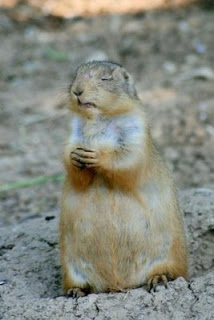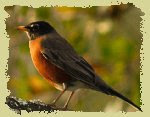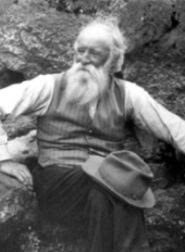Nature's prayer
Just before Thanksgiving last year, NPR interviewed Terry Tempest Williams, author of Finding Beauty in a Broken World. In part of the interview, Ms. Williams talked about prairie dogs. She said:
“I watched prairie dogs every day, rise before the sun, stand with their paws pressed together facing the rising sun in total stillness for up to 30 minutes,” says Williams. “And then I watched them at the end of the day take that same gesture 30 minutes before the sun goes down they would press their palms together in perfect stillness. I don’t mean to anthropomorphize, but when you look at a creature that has survived over the millennium begin and end each day in that kind of stance, it causes one to think about one’s own life and the speed and rapidity in which we live.”
 The Thomas Merton of Prairie Dogs
The Thomas Merton of Prairie Dogs(Photo from Parade Magazine)
A few days ago I sat reading a book in one of the rooms in house that facing onto the garden. It’s a pretty bleak place this time of year, when the buds on the trees haven’t yet appeared, the garden is brown and scraggy and the pond’s mostly algae. Only the early-blooming witch hazel offers a hopeful yellow dazzle. On the deck, the wrought-iron table looks quite lonely without chair or umbrella. However, the garden faces west, which means the sun sets there, and in winter the sunsets are most beautiful. The trees are all black-silhouettes, and sometimes there’s snow on the ground, and the shadows are long and blue, and the light is purple and peach and apricot and rose and gold against those darkening, skeletal trees. I have hung three prisms in the windows, to catch the late-day light and scatter jewels across the walls. I often stop whatever I’m doing and simply watch the light change, soften, hush… a prayer…
As I sat there, a robin flew onto the iron table. He perched with his back to me, and faced the setting sun. I watched the bird, who watched the sunset, and I watched with him. Both of us were silent for a few moment and then, as though in some sort of ecstasy he couldn’t contain, the little little bird threw back his head and sang what seemed to me like a song of exultant praise.
I am reminded of John Burroughs, the American essayist and naturalist so important to the early evolution of the U.S. conservation movement. In his first book, “Wake Robin,” he said this:
“At sunset, on the tops of the tall maples, with look heavenward, and in a spirit of utter abandonment, he carols his simple strain. And sitting thus amid the stark, silent trees, above the wet, cold earth, with the chill of winter still in the air, there is no fitter or sweeter songster in the whole year round. It is in keeping with the scene and the occasion. How round and genuine the notes are, and how eagerly our ears drink them in! The first utterance, and the spell of winter thoroughly broken, and the remembrance of it after all.”

Do these animals and birds really pray? Probably not. Not in the way we think of prayer, as a conscious, intentional act of petition or praise. Still, what prayer is sweeter than joy? What prayer more powerful than simple, grateful attention? To respond to the life-giving light of morning and the gentle hush of evening’s shadow is perhaps the purest form of prayer. What a miracle it seems to me that the animals and the birds remember what my Mohawk friends call their “original instructions from The Creator,” even when I so often forget.
Copyright 2008 Lauren B. Davis For permissions: laurenbdavis.iCopyright.com

🥰